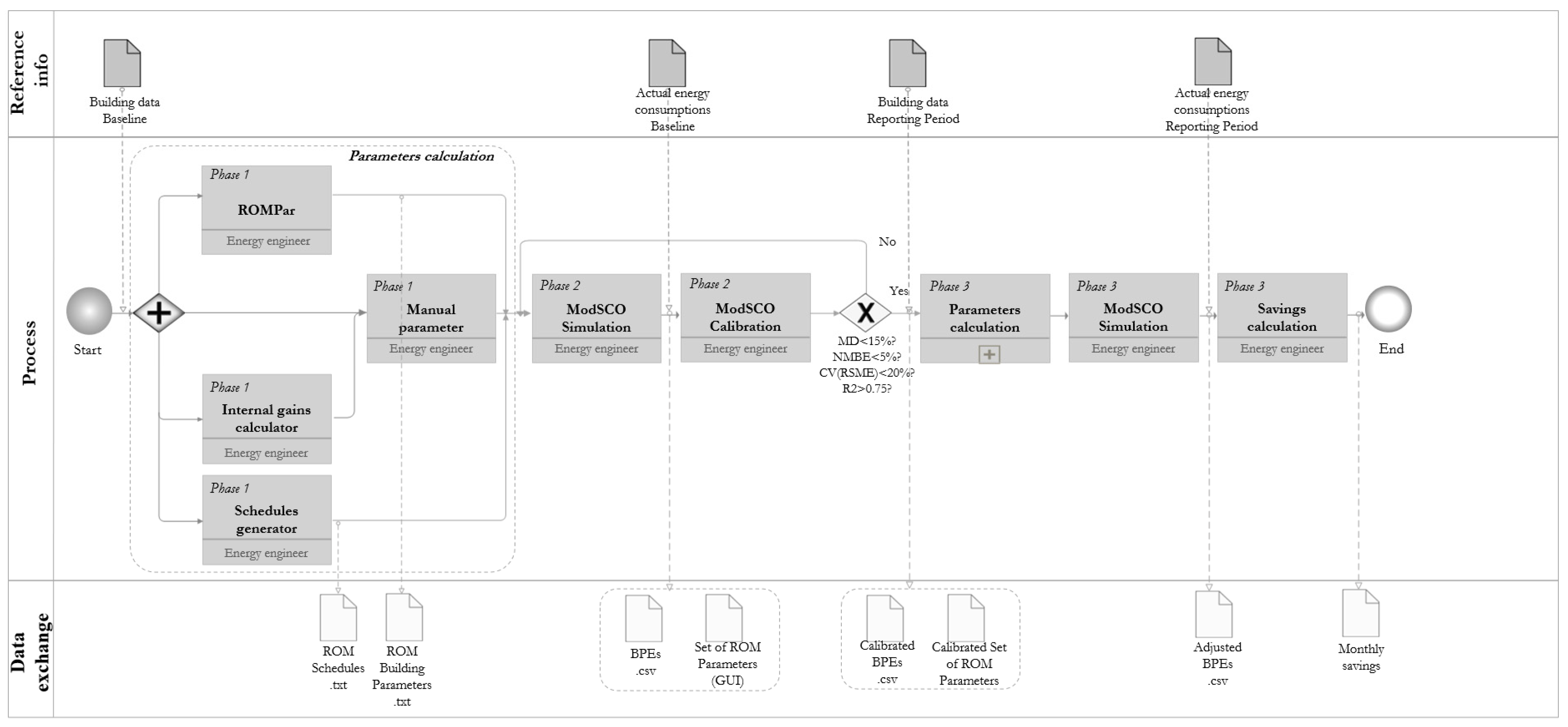ModSCO a Web Application Based on a Grey-Box Model to Support the Estimation of the Energy Savings in Building Retrofits †
Abstract
:1. Introduction
2. ModSCO Web Application
2.1. ModSCO Core Platform
2.2. ModSCO Work-Flow
- Normalised Mean Biased Error → NMBE < 5%
- Coefficient of Variation of Root Mean Square Error → CV(RMSE) < 20%
- Coefficient of Determination → R2 > 0.75
- Monthly Deviation < 15%
3. The ModSCO Test Case
4. Conclusions
Funding
Data Availability Statement
Conflicts of Interest
References
- Kranzl, L.; Toleikyte, A.; Müller, A.; Hummel, M.; Heiskanen, E.; Marschoss, K.; Rohde, C.; Kockat, J.; Steinbach, J.; Regodón, I.D.; et al. Laying Down the Pathways to Nearly Zero-Energy Buildings. A Toolkit for Policy Makers. Available online: https://www.entranze.eu/files/downloads/D6_11/entranze_report_final.pdf (accessed on 25 September 2021).
- Augustins, C.; Jaunzems, E.; Rochas, D. Managing energy efficiency of buildings: Analysis of ESCO experience in Latvia. Energy Procedia 2018, 147, 614–623. [Google Scholar] [CrossRef]
- Efficiency Valuation Organization. International Performance Measurement and Verification Protocol Core Concepts. Available online: https://evo-world.org/en/products-services-mainmenu-en/protocols/ipmvp (accessed on 25 September 2021).
- Python.org. Available online: https://www.python.org/ (accessed on 25 September 2021).
- Andersson, C.; Akesson, J.; Fuhrer, C. PyFMI: A Python Package for Simulation of Coupled Dynamic Models with the Functional Mock-up Interface. Tech. Rep. Math. Sci. 2016, 2, 1–40. [Google Scholar]
- Functional Mock-Up Interface. Available online: https://fmi-standard.org/ (accessed on 23 September 2021).
- JModelica.org. Available online: https://jmodelica.org/ (accessed on 23 September 2021).
- Fritzson, P.; Engelson, V. Modelica—A unified object-oriented language for system modeling and simulation. Lect. Notes Comput. Sci. 1998, 1445, 67–90. [Google Scholar]
- Dymola by Dassault Systèmes®. 2021. Available online: https://www.3ds.com/it/prodotti-e-servizi/catia/prodotti/dymola/ (accessed on 20 September 2021).
- Piccinini, A.; Hajdukiewicz, M.; Keane, M.M. A novel reduced order model technology framework to support the estimation of the energy savings in building retrofits. Energy Build. 2021, 244, 110896. [Google Scholar] [CrossRef]
- Bubble.io. Available online: https://bubble.io/ (accessed on 11 September 2021).
- Business Process Model and Notation (BPMN), Version 2.0. 2010. Available online: https://www.omg.org/spec/BPMN/2.0/PDF (accessed on 25 September 2021).
- D’Angelo, L.; Piccinini, A.; Seri, F.; Sterling, R.; Costa, A.; Keane, M.M. BIM-based business process model to support systematic deep renovation of buildings. Build. Simul. Conf. Proc. 2019, 1, 137–144. [Google Scholar] [CrossRef]
- Drgoňa, J.; Arroyo, J.; Figueroa, I.C.; Blum, D.; Arendt, K.; Kim, D.; Ollé, E.P.; Oravec, J.; Wetter, M.; Vrabie, D.L.; et al. All you need to know about model predictive control for buildings. Annu. Rev. Control 2020, 50, 190–232. [Google Scholar] [CrossRef]
- Giretti, A.; Vaccarini, M.; Casals, M.; Macarulla, M.; Fuertes, A.; Jones, R.V. Reduced-order modeling for energy performance contracting. Energy Build. 2018, 167, 216–230. [Google Scholar] [CrossRef] [Green Version]
- Piccinini, A.; D’Angelo, L.; Seri, F.; Deane, C.; Sterling, R.; Costa, A.; Giretti, A.; Keane, M.M. Development of A Reduced Order Model for Standard-Based Measurement and Verification to Support ECM. In Proceedings of the 16th IBPSA Conference, Rome, Italy, 2–4 September 2019; pp. 4180–4187. [Google Scholar] [CrossRef]
- Integrated Environmental Solutions|IES-VE. Available online: https://www.iesve.com/ (accessed on 11 September 2021).

| Statistical Indices | IPMVP Limits | Natural Gas | Electricity | ||
|---|---|---|---|---|---|
| ModSCO | IES-VE | ModSCO | IES-VE | ||
| NMBE | <±5% | 0.25% | 1.18 | 2.70% | −0.66 |
| CV_RMSE | <20% | 6.06% | 7.49 | 15.05% | 13.30 |
| R2 | >75% | 0.965 | 0.93 | 0.978 | 0.983 |
Publisher’s Note: MDPI stays neutral with regard to jurisdictional claims in published maps and institutional affiliations. |
© 2021 by the authors. Licensee MDPI, Basel, Switzerland. This article is an open access article distributed under the terms and conditions of the Creative Commons Attribution (CC BY) license (https://creativecommons.org/licenses/by/4.0/).
Share and Cite
Piccinini, A.; Seri, F.; D’Angelo, L.; Yousefigarjan, S.; Keane, M.M. ModSCO a Web Application Based on a Grey-Box Model to Support the Estimation of the Energy Savings in Building Retrofits. Environ. Sci. Proc. 2021, 11, 31. https://doi.org/10.3390/environsciproc2021011031
Piccinini A, Seri F, D’Angelo L, Yousefigarjan S, Keane MM. ModSCO a Web Application Based on a Grey-Box Model to Support the Estimation of the Energy Savings in Building Retrofits. Environmental Sciences Proceedings. 2021; 11(1):31. https://doi.org/10.3390/environsciproc2021011031
Chicago/Turabian StylePiccinini, Alessandro, Federico Seri, Letizia D’Angelo, Shima Yousefigarjan, and Marcus M. Keane. 2021. "ModSCO a Web Application Based on a Grey-Box Model to Support the Estimation of the Energy Savings in Building Retrofits" Environmental Sciences Proceedings 11, no. 1: 31. https://doi.org/10.3390/environsciproc2021011031
APA StylePiccinini, A., Seri, F., D’Angelo, L., Yousefigarjan, S., & Keane, M. M. (2021). ModSCO a Web Application Based on a Grey-Box Model to Support the Estimation of the Energy Savings in Building Retrofits. Environmental Sciences Proceedings, 11(1), 31. https://doi.org/10.3390/environsciproc2021011031






